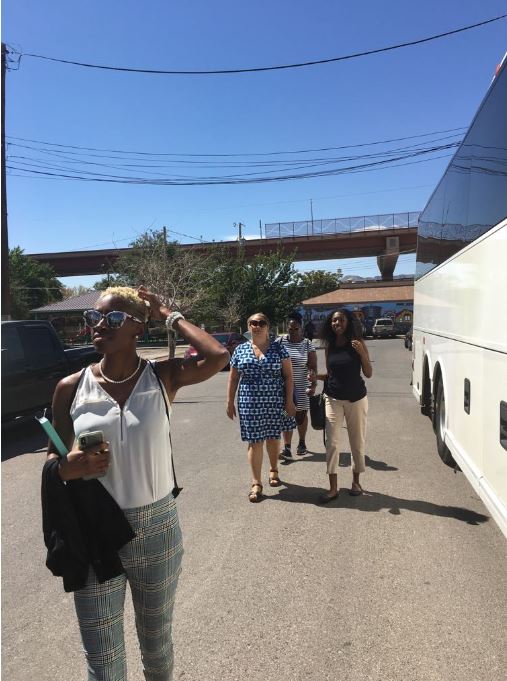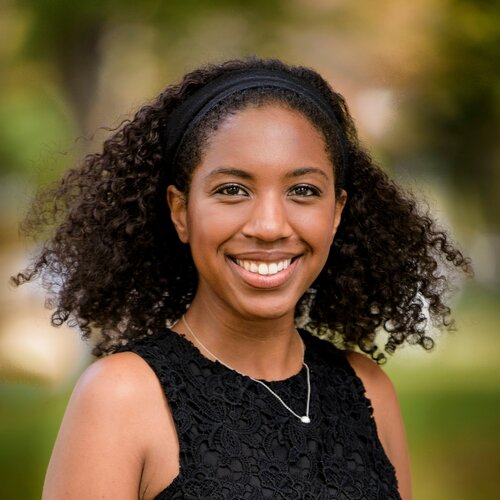By Gabrielle Sims, Project Associate, Shah Family Foundation
Going PLACES is an occasional blog series featuring the voices and experiences of TFN’s PLACES Fellows. For more information on the fellowship, and to read past blog posts from our fellows, visit here.

El Paso was the city that I was most excited to visit over the course of my PLACES journey. Before the visit, I only knew two things about El Paso: that it had a rich and vibrant culture and that it was the epicenter of the immigration debates garnering national attention due to President Trump’s policies and rhetoric. My state of mind was that this was going to be a trip that was emotionally and intellectually heavy but that I’d learn a lot from my peers in my PLACES cohort. I spent many days reading articles and looking over past notes that I took on our previous site visits to Newark and Bismarck to make sure that I could look at my time in El Paso through the same lens.
In short, I was ready to absorb the learnings. That was until August 3, when a white supremacist drove 11 hours to El Paso to take the lives of 22 people at the city’s local Walmart.
And there it was.
Another mass shooting. Another hate crime on American soil. Another round of our politicians and their banal scripts saying that mass shootings are a mental illness problem and not a gun problem and that one “lone wolf” doesn’t mean that this country condones white supremacy. After the shooting, I was uneasy about visiting El Paso because I assumed there would be heaviness in the community that I wasn’t ready (willing?) to process because I wasn’t sure if I had the tools to adequately help.
The PLACES site visit to El Paso was a little over a month after the mass shooting and several months after news stories were filled with the crime of children locked in cages in detention centers. In order to absorb what we needed from the visit, our PLACES cohort reflected on what it meant to be in a community that’s recently experienced trauma and what we could learn by being honest about the perceptions we were carrying about El Paso. We spent the first day visiting several sites. The first was a historical center where we learned from the white men who worked there how “inclusive” El Paso was, and that the immigration issue was more complicated than both liberal and conservative media led people to believe.
The second site was Abara Frontiers, a local non-profit that worked with young people on the border who were new to the country. They do incredible work and took us to meet two border patrol officers to learn more about their roles. The border patrol officers, both Latinx, were eager to share about the danger of their duty to “protect the border from bad guys.” When asked about the children who were locked in cages, one of the officers lapsed into talking points stating that “the news stories were wrong, [border patrol] would never lock children in cages and that the lawyer who broke that story wasn’t even present that day.” Despite the reality that there were photographs and videos of children in cages in detention centers, the border patrol officer asked us to believe her because she knew the “real story.” After the presentation from the border patrol officers, we visited an asylum shelter for recent immigrants before they connected with family elsewhere in the United States. I couldn’t imagine what these families had gone through on their journey to get to the asylum shelter so I didn’t think about it, I didn’t ask our site lead — I just focused on the smiles on the children’s faces.
The conflicting narratives at the history center and from the border patrol officers infuriated me but I pushed those inconvenient feelings aside. I needed to cling to the hope that showed on the children’s smiling faces and ignore the worried looks on their parent’s faces to continue on.
Later that night, our cohort went for dinner and reflected on the day but mostly the lighter things, like the weather and some of the contradictions in the stories that some of our guest speakers told us. I slept well that night and was ready for the next day. The next day, several in my PLACES cohort expressed their rage about what they saw at the asylum center and the Latinx border patrol agents’ complicity in the system that oppressed their own people. I felt a sense of disappointment in myself that I was so numb to everything I saw the previous day.
This is what white supremacy does. It wants those of us deeply committed to change to compartmentalize and forget about the reality around us. It wants us to continue to keep our fellow human beings in our “thoughts and prayers” but take no action to improve their lives through policy. And most importantly, it wants us to feel powerless in the face of its power, lies and resistance to change.
The reflection questions that Bina M. Patel, our facilitator, asked our cohort to think about in El Paso were: “What are you giving to communities as a healer?” and “How are you showing up?’’Before the experience in El Paso, I wrote that I give communities my “listening ear” and that I “show up humbly” without giving thought to how passive those responses were. At the end of my time in El Paso, especially after visiting the Walmart, I realized that communities deserve not only my “thoughts and prayers” and my “listening ear” but my anger at the system, my disappointment at the inertia of our political leaders and most importantly my commitment to sharing their stories.
I will never forget the wall of flowers and the photographed faces of the people that were murdered in cold blood at the Walmart — mothers, sons, cousins, fathers. The pain in El Paso is real but so is the city’s resilience. El Paso is strong. Since our PLACES visit in El Paso, there have been at least two other mass shootings in America. Statistically, there was one mass shooting every fifteen days in 2019.
Change will not happen if we remain passive. Change takes time, courage and consistently showing up no matter how many times the system tells us “no.” Most importantly, creating change requires us to tell the truth about our past and present no matter how uncomfortable it is. My time in El Paso has inspired me to show up more authentically in my leadership on racial justice issues. Social justice can’t happen through silence.
“Never again” is an empty phrase if we don’t address our past.
About the Author

Gabrielle Sims is currently the
project associate at Shah Family Foundation. Previously she was the program associate for the Neighborhoods and Housing Strategy at the Boston Foundation and previously worked with Freedom House and NeighborhoodWorks America.
Want to learn more about Gabrielle? Check out her interview here with La Piana Consulting where she breaks down how she brings her values into her work, how she practices selfcare, and how she learned to reclaim her time.
